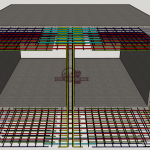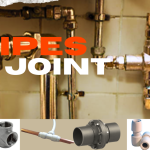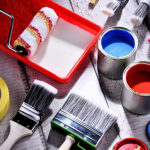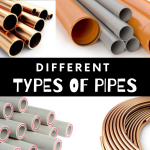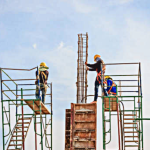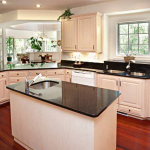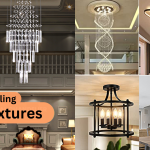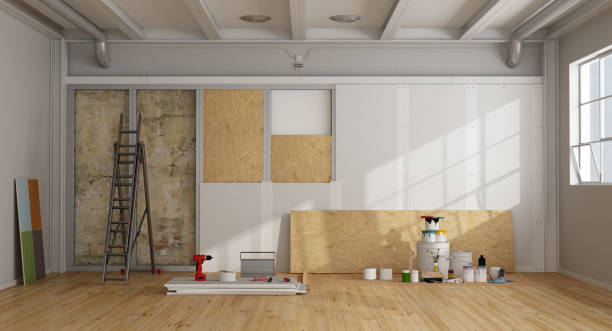
What is drywall?
Drywall is a type of construction material that is used to cover the framework of walls and ceilings. It’s made of gypsum, which is an abundant, naturally occurring material, making it an eco-friendly choice. The gypsum is combined with other components to create a slurry, which is then placed between two layers of paper and dried. The paper type and thickness, as well as the chemicals in the slurry, determine the type of drywall.
On the inside of residential and commercial structures, drywall offers fire protection and soundproofing for walls and ceilings. It’s fastened to the framework structure, then taped to cover the gaps between the drywall panels. Then, mud is used to smooth the transition and repair the screw holes. When the mud has dried, the wall is finely sanded and textured or painted, based on the desired appearance.
Common Types of Drywall
There are various different types of drywall, which are generally distinguished by the color of the paper that surrounds them. Different paper types as well as the addition of chemicals to the slurry cause the variations.
1. Regular drywall
Regular drywall is used in ceilings and walls in homes and businesses and is also known as “white board.” For residential applications, 1/2 inch is the most common thickness. The most common drywall sheet dimension is 4′ x 8′, but longer lengths of up to 16′ are available for high ceilings. For modest repairs and to make the sheets simpler to handle, home improvement stores supply 2′ by 2′ drywall.
2. Mold-resistant drywall
Mold-resistant drywall, also known as green board, has a thicker paper backing than ordinary drywall and is wax-coated for further moisture resistance. It also includes a non-organic fiberglass mesh that prevents mold from growing by eliminating the feeding source (called “paperless drywall”). Mold-resistant drywall is commonly used in bathrooms, kitchens, and laundry rooms, as well as a tile backer. There is mold-resistant mud available. It is important to keep in mind that moisture-resistant drywall is not the same as mold-resistant drywall.
3. Plasterboard
Plasterboard, commonly known as blue board, is a substrate for plaster applications that is similar to lath in lath and plaster walls. A thin layer or coats of plaster must be applied to the whole surface of the plasterboard. Since the face paper absorbs moisture, the plaster finish layer adheres to the drywall better. It’s used to provide the impression of lath and plaster in older homes.
While all drywall has some soundproofing capabilities, soundproof drywall contains additional wood fiber, gypsum, and polymers to enhance the sound transmission class (STC) over ordinary drywall. STC is a rating system that assesses how much noise a material can block, similar to the Richter scale. When additional soundproofing is needed, such as between the living area and common walls, soundproof drywall is employed. It has a higher density than ordinary drywall and is therefore more difficult to work with.
5. Fire-resistant drywall
Fire-resistant drywall is being used in garages and basements around potentially flammable equipment. It includes fiberglass, which slows the spread of fire and does not burn as quickly as conventional gypsum. There are two varieties of fire-resistant drywall: Type X and Type C. Type X provides up to one hour of fire prevention and is 5/8″ thick. It may be applied in numerous layers to give additional protection if necessary. Type C is just the same as Type X, but it does not shrink when burned. It’s mostly utilized in ceilings to protect them from collapsing during a fire.
6. VOC-absorbing drywall
VOC-absorbing drywall is a relatively new product that absorbs chemicals and other volatile organic compounds inside the drywall, rendering them inert. Other building materials, as well as cleaning items we use on a daily basis, include these compounds. For up to 75 years, the drywall can be painted or covered with a light wallcovering.
The Benefits of Drywall
There are several reasons why drywall is so popular. First and foremost, it is affordable. It is also flame-resistant, making it one of the safest building materials.
It’s also a great insulator. This is ideal for keeping heat in during the winter and cool air in during the summer. Drywall is a great option for all of these reasons and more! You may get more information from a reputable local drywall firm.
Affordability
Everyone can afford drywall and drywall services. It is a popular choice among homeowners due to its cost-effectiveness. It’s far less expensive than plaster or paneling. When you combine the low cost of drywall with its simplicity of installation and repair, it’s no surprise that it’s a popular choice. Not only is drywall material inexpensive, but it can also be repaired or replaced.
Beauty and Elegance
Drywall for homes and workplaces has a simple yet attractive look. It can be painted over and over again, allowing you to quickly and simply modify the look and feel of a space. Drywall is one of the best-looking and most affordable materials available when properly installed.
Insulation Properties
There aren’t many affordable products that can compare to drywall when it comes to insulation. It improves the temperature retention of any room, whether cold or warm air is present. Better insulation will not only make your rooms cozier and more comfortable, but it will also help you save money on your energy bills throughout the year. To keep rooms with drywall warm, heaters won’t have to work as hard. Air conditioners and drywall are both in this category. A qualified drywall specialist can explain this to you in further detail.
Fire Resistant Properties
The spread of flames is slowed by the use of drywall. This makes it much easier to put out flames in your home or commercial building. The benefits of drywall in terms of safety alone make it well worth the price, which is already affordable! Drywall can help to prevent the spread of a fire and protect your house or workplace from any further damage. It may even contribute to the preservation of life, the most valuable commodity on earth. For drywall installation and repair, always use a reputable business.
Ease of Repair and Installation
Drywall is simple to install for experts, making it an ideal choice. Not only is the installation quick and simple, but repairs are also much simpler than with many other wall materials. Large sections of drywall are installed. However, owing to numerous techniques used by professionals, it is possible to fix it without having to replace the entire part. A professional drywall replacement contractor will know what to do.
These are all excellent arguments for drywall’s advantages. If you’re building, remodeling, or just upgrading your house or workplace, drywall is always a good option. In your location, look for a local drywall installation and repair firm.

